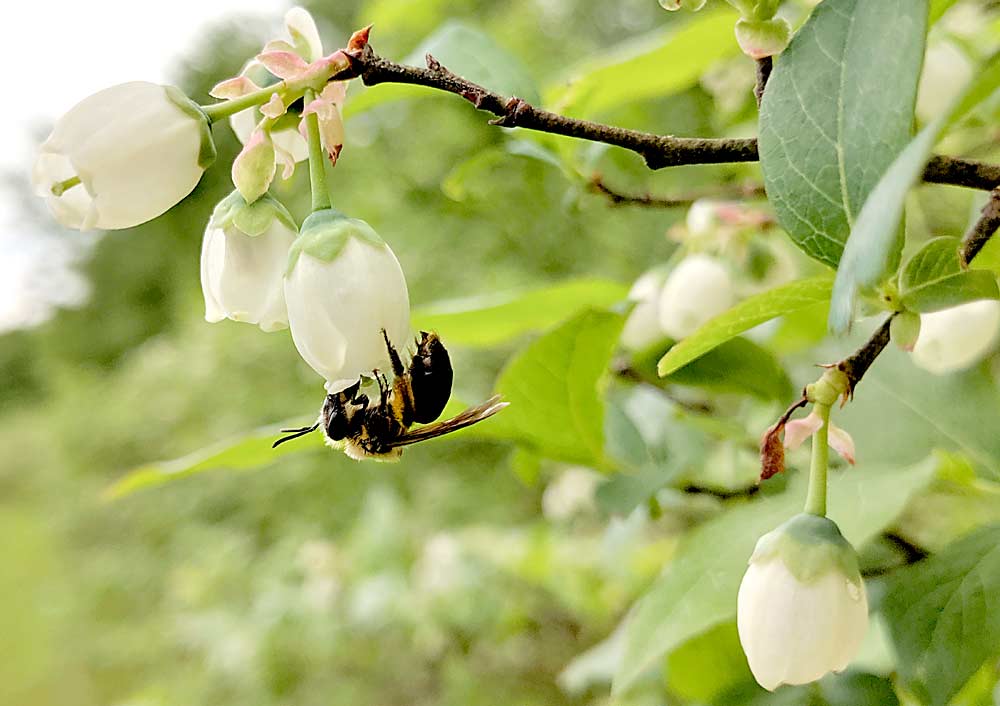
Blueberry pollinators — honey bees and wild bees — are under stress, and growers need to take steps to make their farms as bee-friendly as possible.
A project studying wild bees in Southwest Michigan found that their populations declined significantly in the region’s blueberry fields between 2004 and 2018. MSU personnel put out traps (soapy water in a colored bowl) during bloom in 15 blueberry farms over the 14-year experiment. Not only did they find a reduction in wild bee populations, they also found a significant shift in the kinds of bees caught in the traps, including a lot fewer mining bees — a significant finding given that, for some species of mining bee, blueberry pollen is their only food source.
Mining bees, a large group of species in the genus Andrena, are wild bees that build nests underground.

“Mining bees are closely tied to blueberries,” Kelsey Graham, a postdoctoral research associate at Michigan State University, said during a talk at the Great Lakes Fruit, Vegetable & Farm Market EXPO in December. “It’s not good those populations are going down.”
No one is sure why there are fewer wild bees in the fields, but there are theories. The first big decline came in 2012, after an early bloom followed by severe frost events devastated Michigan’s fruit crops. The frosts “knocked back” blueberry flowers, which probably affected mining bee populations by taking away their main food source. Pesticide exposure is another possible factor. In order to combat spotted wing drosophila, growers are spraying more than in the past, which means wild bees are coming in contact with more pesticides, she said.
Wild bees also are experiencing worrying declines in Pennsylvania, where they provide most of the pollination services for the state’s apples and pumpkins. The lab of Margarita López-Uribe, an assistant professor with Penn State University, compiled a list of 437 wild bee species in the state; 13 percent of those species have not been seen since 2000.
“We think a number of them could be in decline,” she said.
As for managed honey bees, Pennsylvania loses about half of them every year, López-Uribe said.
In Michigan, commercial honey bees, which provide about 80 percent of the pollination services for the state’s blueberries, also need help. In a different experiment, Graham collected pollen from managed bees (both honey bees and bumble bees) in Michigan blueberry regions and found traces of dozens of pesticides. The pesticides came not only from blueberry farms but from surrounding fields. Bees forage in the broader landscape (honey bees can forage up to 2 miles away), and growers should keep that in mind when spraying, she said.
There are things growers — even those not growing blueberries — can do to reduce bee exposure to pesticides in their fields. Graham shared the following recommendations:
—Use reduced-risk pesticides when possible.
—Time spray applications. Spray after sunset or before sunrise, or when air temperatures are below 50 degrees Fahrenheit, to minimize exposure risk to bees, which forage during the day. Spray when wind is low, to avoid drift. In Michigan, use Enviro-weather pest and disease models to time applications.
—Calibrate your sprayer. Accurate calibration will ensure better coverage. Better coverage will lead to better pest control and fewer applications.
—Reduce drift. Use drift-reduction technologies, such as air-induction nozzles, to reduce off-target deposition.
—Mow flowering weeds. This can reduce bee attraction to weeds that have been sprayed. Use herbicide on weeds growing into canopy bushes, or pull them out by hand.
—Establish wildflower habitat. Bees need flowers for food throughout the growing season. •
—by Matt Milkovich
Related:
—Pollination calculation: Every bee counts
—What wildflowers are best to attract bees?






Leave A Comment